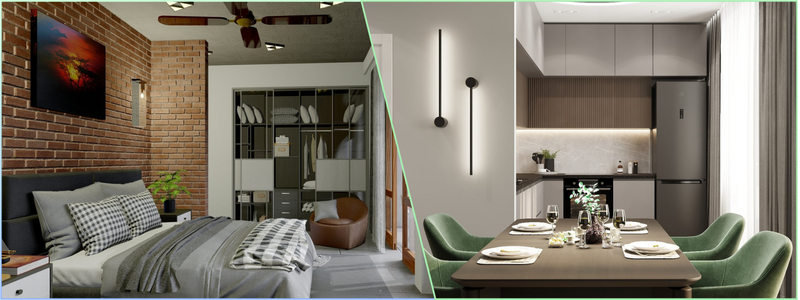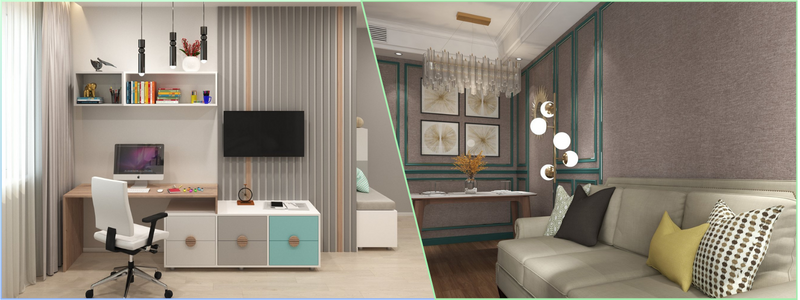Do you know the top photorealistic furniture rendering techniques used for interior design companies? 3D renderings have changed many industries, especially product design, interior design, and marketing. Previously, taking videos and photographs of products or properties was the only marketing method used. But with the digital revolution, the old-school advertising style has evolved. Because of technological advancements, 3D renderings options are affordable, readily available, and provide quality results.
However, while 3D furniture rendering tools offer highly customizable and realistic immersive visualizations, working with a reliable and trusted team that delivers the results you want using techniques and software that meet the industry’s standards is imperative. In this article, you will learn more about photorealistic furniture rendering and the different techniques interior design companies can use to showcase their products to the world.
RELATED: How to get the best 3D rendering services for furniture design
What is photorealistic furniture rendering?
Photorealistic furniture rendering services is one type of digital rendering that boasts realistic and crisp details similar to real life. If you print a photorealistic furniture render and put it beside an actual photo of the same piece of furniture, even the most seasoned experts would hesitate to distinguish the real deal from the render. As expected, these 3D furniture renderings are often used in interior design, furniture catalogs, product design and stereotypes, real estate, and architectural visualization.
Photorealistic furniture renderings showcase how furniture will look in a particular setting or environment. Interior design companies often use these renders to evoke emotions and add a dramatic touch to lure customers and convince them to purchase. Today, large company catalogs feature photorealistic furniture rendering rather than actual photographs of the products.
RELATED: How CGI can help marketing for your furniture business
Importance of photorealism in 3D furniture rendering
Whether it is a regular photo rendering or a photorealistic furniture rendering doesn’t matter. 3D furniture rendering is now critical in interior design, product marketing, and business promotion. This is because these fields need high-quality, crisp images, which are the primary purpose and function of 3D photorealism. In addition to this, hiring a 3D furniture modeling professional for furniture renderings are also more affordable than traditional furniture photography.
It is not a secret how expensive photography can get; it is also time-consuming. Aside from preparing the props, you also need to set up the space, make some edits, and hire a team of several people to make everything work. Alternatively, photorealistic furniture renderings only need reliable rendering software and a 3D rendering professional who knows what to do and how to do it. This is why many interior design companies now prefer photorealistic furniture rendering instead of traditional photography.
RELATED: 3D Rendering furniture vs. photography: which is better for your furniture company?
Different types of photorealistic furniture renderings
The following are some common types of photorealistic furniture renderings that interior visualization companies often use in their campaigns. Each type highlights and emphasizes the delicate features of the furniture products.
Detailed renders
Detailed renders can help you illustrate the finest details of your furniture pieces with close-up images in 3D. A close-up camera angle will focus on every feature that makes your furniture’s design special and unique from the rest.
Lifestyle images
Lifestyle images let you show the product in a realistic setting. It is compelling, attention-grabbing imagery that your potential customers can’t resist.

Teaser renders
Are you planning to release a new piece of furniture soon? If yes, your best action is to prepare the market with teaser renders that will make people talk and wonder what it is. You can use teaser renders to create anticipation and spark interest in your new product to boost your sales immediately.
RELATED: How furniture prototyping gives you an advantage during the manufacturing process
Simple studio renders
Simple studio renders are precisely that: simple and clean. The studio image is often set on a white background and shows nothing else but the furniture piece. Of course, you can also add any background color of your choice to bring more impact to the image and emphasize the materials of the design. These are the types of images that work well for online stores like eBay and Amazon. Isolated images are also some of the most powerful selling tools you can use, showcasing the design of your product front and center.
Common techniques for photorealistic furniture rendering
The following are some common techniques that 3D artists use to come up with professional photorealistic furniture renderings:
Precise size and scale depiction
The simplest way to showcase the dimensions of any piece of furniture is to compare it to everyday items that everyone knows. For example, if you want to show the dimensions of a cupboard, the 3D artist will put it next to a standard single-door fridge to let customers imagine its size easily. For this purpose, a 3D artist creates propped, and lifestyle furniture renders similar to what photographers do. They produce photorealistic settings highlighting the best features and showing the product’s dimensions.
RELATED: Furniture marketing services: 12 Reasons why companies choose 3D CGI over photography
3D scenes in full detail
The photorealistic background is one of the best things about furniture renders. The 3D furniture rendering professional chooses the best environment and creates professional-style scenes with striking realism. They also select the ideal interior décor and fill the view of the exterior with shops, cars, and people depending on what is most suitable for the scene. CGI artists who create outdoor furniture renders can also develop realistic landscapes that feature all necessary elements, from a mystical verdant forest to the warm golden sand of the beach and sparkling clear turquoise waters.
Natural materials and textures
Authentic presentation of the materials used for objects is critical to creating highly photorealistic furniture renders. Professional 3D artists avoid impeccable-looking materials and textures for this purpose because they look too good to be true. CGI experts use 3D rendering software instead to develop minor imperfections that make an object more beautiful. For example, those wear spots on a vintage armchair’s velvet surface can make the image look classier and richer.
Today’s 3D visualization software has greatly improved to the extent that 3D product rendering firms can now produce photorealistic close-ups of products that highlight the quality of materials used. They scrutinize samples of the materials, look into the different properties, and create stunning 3D furniture renders using specialized software.
RELATED: Augmented reality: AR as a great marketing tool for furniture industry companies
Photographic approach to viewpoints and composition
Realistic 3D furniture rendering and photography resemble each other regarding composition techniques. Each shot has accents and a central focus, while the composition may combine the elements below:
- Camera angles highlight specific scene elements that attract viewers’ attention. A comprehensive demonstration of the benefits of furniture needs several views from various angles.
- The focal length ensures that the eyes of the viewers will go directly to the shot’s main hero instead of wandering around the image.
- Framing focuses on the main subject by blocking the other portions of the image with something else in the scene. This also adds layers and creates a context to the image.
- Positioning and camera angles are inseparably connected. A 3D rendering company adjusts the camera position before changing the angles, whether the view is from a low-angle shot or from above.
3D artists often learn the fundamentals of photography art to develop professional compositions.
RELATED: 3D Furniture visualization and rendering process: how to create high-end 3D content

Smart lighting systems
Lighting is crucial in photorealism to prevent the flatness of 2D product images. It sets the ambiance, creates more depth, and highlights the textures and forms of objects. Professional photorealistic rendering experts use the tools below to create photorealistic furniture renderings and a more intelligent lighting system:
- Balance of shadow and light is critical for realistic photos because the lighting depends on shadow, and shadow won’t exist without light. The shadows’ natural positioning according to the sources of light makes 3D furniture render more realistic.
- Directions of light define the realism of 3D furniture renders to a great extent. 3D artists use a three-point lighting system that includes a backlight, fill light, and key light, and each point has its function, focus, and angle.
- Artificial and natural lighting depends on the light source, which can be electricity, the sun, stars, the moon, or a combination of the two. Various light sources create the ambiance of furniture renders.
- The tonal range of lighting is essential to build the color harmony between absolute black and pure white. The right choice of tones can define light dispersion, contrasts, and softness and form a balance between the tonal extremes.
A carefully selected lighting system can make 3D furniture renders look more organic and set a particular mood in any product image. With all the benefits of photorealistic furniture rendering, more interior companies are now switching from photography to using 3D CAD design experts for furniture renderings. The level of detail and realism achieved through 3D rendering enhances the overall quality and appeal of furniture visuals, allowing companies to showcase their products in a compelling and immersive manner. A professional 3D rendering designer will produce the best and most stunning results.
How Cad Crowd can assist
Whether launching a new furniture product or looking to enhance your marketing visuals, Cad Crowd’s talented designers will ensure your renders capture your design vision and resonate with your target audience. Request a free quote from Cad Crowd and take the next step in achieving your business goals.
